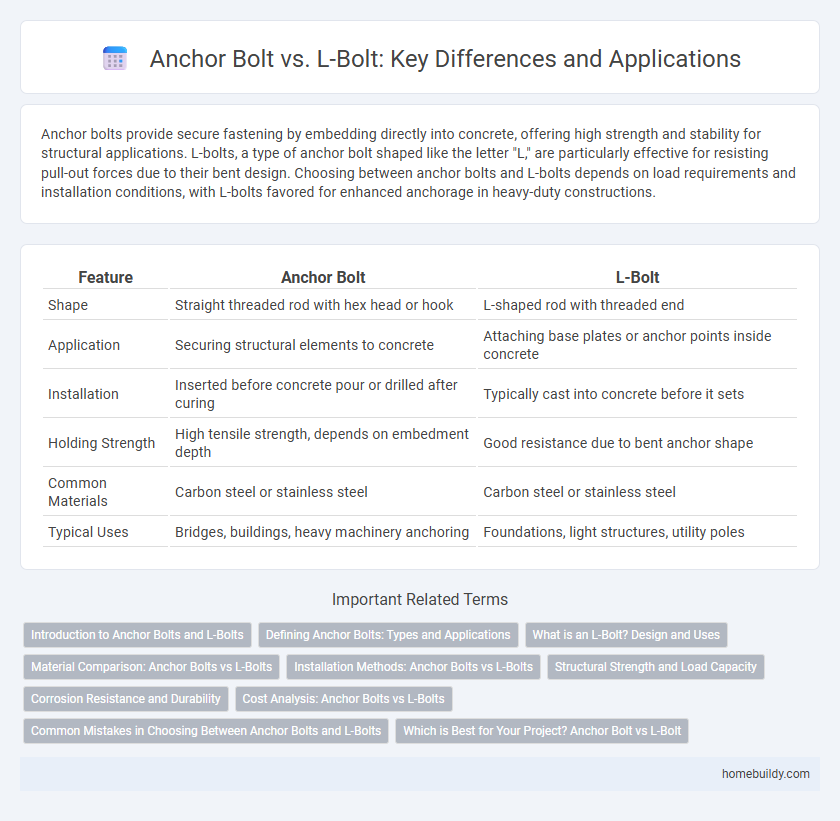Anchor bolts provide secure fastening by embedding directly into concrete, offering high strength and stability for structural applications. L-bolts, a type of anchor bolt shaped like the letter "L," are particularly effective for resisting pull-out forces due to their bent design. Choosing between anchor bolts and L-bolts depends on load requirements and installation conditions, with L-bolts favored for enhanced anchorage in heavy-duty constructions.
Table of Comparison
| Feature | Anchor Bolt | L-Bolt |
|---|---|---|
| Shape | Straight threaded rod with hex head or hook | L-shaped rod with threaded end |
| Application | Securing structural elements to concrete | Attaching base plates or anchor points inside concrete |
| Installation | Inserted before concrete pour or drilled after curing | Typically cast into concrete before it sets |
| Holding Strength | High tensile strength, depends on embedment depth | Good resistance due to bent anchor shape |
| Common Materials | Carbon steel or stainless steel | Carbon steel or stainless steel |
| Typical Uses | Bridges, buildings, heavy machinery anchoring | Foundations, light structures, utility poles |
Introduction to Anchor Bolts and L-Bolts
Anchor bolts and L-bolts are essential fasteners used in construction to secure structural elements to concrete foundations. Anchor bolts typically have a straight or bent end embedded in concrete, providing strong resistance against shear and tension forces, while L-bolts feature an L-shaped bend that enhances grip and stability within the concrete. Both types are selected based on load requirements, installation conditions, and the specific needs of the construction project for optimal structural integrity.
Defining Anchor Bolts: Types and Applications
Anchor bolts are critical fasteners used to secure structural elements to concrete, available in various types such as wedge, sleeve, and J-bolts, each designed to withstand different load requirements and environmental conditions. L-bolts, a subtype of anchor bolts, feature an L-shaped end that provides enhanced resistance to lateral forces, commonly used in foundation and equipment anchoring. Selecting the appropriate anchor bolt type depends on the specific application, load demands, and installation environment to ensure structural stability and safety.
What is an L-Bolt? Design and Uses
An L-bolt is a type of anchor bolt characterized by its distinctive L-shaped bend, which provides enhanced holding power in concrete foundations. Its design allows easy embedding into concrete, making it ideal for securing structural frames, columns, and heavy machinery. Widely used in construction and industrial applications, L-bolts offer superior resistance to shear and tension forces compared to standard straight anchor bolts.
Material Comparison: Anchor Bolts vs L-Bolts
Anchor bolts are often made from galvanized or stainless steel, providing superior corrosion resistance and strength for heavy-duty applications, while L-bolts typically use mild steel with limited protective coatings. The material choice in anchor bolts ensures enhanced durability in harsh environments compared to L-bolts, which are better suited for lighter structural loads. Industrial standards favor high-grade materials for anchor bolts to meet stringent safety and longevity requirements.
Installation Methods: Anchor Bolts vs L-Bolts
Anchor bolts are typically embedded in concrete during the pour, ensuring a secure and permanent fastening point for structural elements. L-bolts, characterized by their L-shaped design, are also embedded but often require precise pre-placement into the formwork before concrete is poured to maintain alignment. Installation of anchor bolts involves direct casting into the concrete, while L-bolts rely on accurate positioning and securing within the form to achieve optimal structural support.
Structural Strength and Load Capacity
Anchor bolts provide superior structural strength compared to L-bolts due to their full embedment in concrete, which ensures optimal load transfer and resistance against shear and tension forces. The cylindrical shape and continuous threaded section of anchor bolts enhance their load capacity, making them ideal for applications requiring high tensile strength and stability. In contrast, L-bolts, with their bent shape, generally exhibit lower load capacity and are more susceptible to bending or pullout under heavy structural loads.
Corrosion Resistance and Durability
Anchor bolts and L-bolts differ notably in corrosion resistance and durability, with anchor bolts typically featuring enhanced coatings such as hot-dip galvanization or epoxy to withstand harsh environments. L-bolts, often used in less demanding applications, may lack these protective finishes, making them more susceptible to rust and structural degradation over time. Selecting anchor bolts with premium corrosion-resistant materials like stainless steel significantly extends their service life in construction projects exposed to moisture and chemical exposure.
Cost Analysis: Anchor Bolts vs L-Bolts
Anchor bolts generally incur higher initial costs compared to L-bolts due to their complex manufacturing process and precision requirements. L-bolts, with simpler designs and easier installation, often reduce labor expenses and material waste, offering a more budget-friendly option for standard anchoring needs. A comprehensive cost analysis must consider long-term durability and maintenance, where anchor bolts may justify higher upfront costs through enhanced structural performance and fewer replacements.
Common Mistakes in Choosing Between Anchor Bolts and L-Bolts
Confusing anchor bolts with L-bolts often stems from misunderstanding their specific applications and load-bearing capacities. Anchor bolts are typically embedded in concrete to secure structural elements, while L-bolts, shaped like an "L," provide enhanced resistance to shear forces in fastening. Selecting the wrong bolt type can result in inadequate structural stability and costly repairs due to improper load distribution.
Which is Best for Your Project? Anchor Bolt vs L-Bolt
Choosing between anchor bolts and L-bolts depends on the specific structural requirements and load-bearing needs of your project. Anchor bolts offer superior holding power and are ideal for heavy-duty applications such as securing steel columns, while L-bolts, with their simple L-shaped design, are typically used for lighter loads and concrete fastening. Evaluating factors like tensile strength, installation method, and environmental conditions will determine which bolt type provides the most reliable and cost-effective solution.
Anchor bolt vs L-bolt Infographic

 homebuildy.com
homebuildy.com